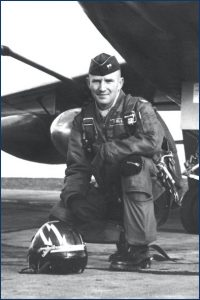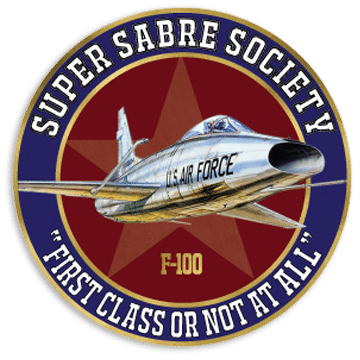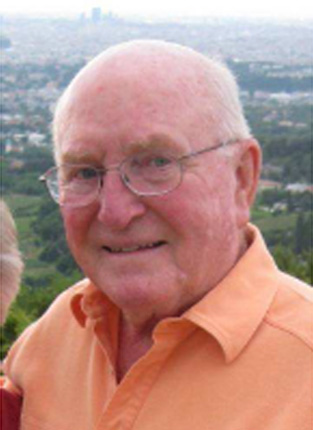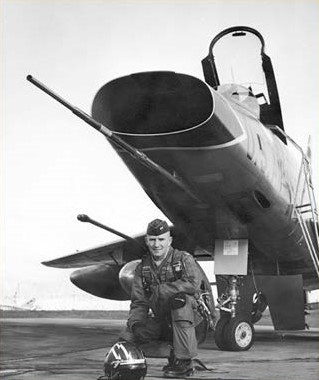After retirement from the USAF I became a stockbroker in the Washington DC area for Merrill Lynch, and later Paine Webber.
 Spangdahlem AB, West Germany, Tuesday, March 1st, 1960
Spangdahlem AB, West Germany, Tuesday, March 1st, 1960
7th Tac Fighter Squadron
Lt. Col. Bob Malloy, CO
Major Bob Melgard, Ops
I was not even on the flying schedule but had some flight commander paperwork to do, so showed up at the Squadron a bit early. The first mission of the morning was for three birds to fly into the “buffer zone” along the East German border and allow some ground techs to get some practice directing an MSQ simulated bomb drop. Two of the three scheduled pilots were ready for the briefing, but no number three.
Being a time hog, I quickly volunteered to fill the empty slot. All was ready when maintenance called to inform us that they couldn’t get three Ds ready, so they would supply two Ds and an F. Now we had another empty seat. With permission from the front office, I invited our personal equipment Tech Sergeant to ride the back seat in the F with me driving.
With that problem solved, in walked Lt. Bill Kaa, a member of my flight. Knowing he needs to log some hood time, we switch the Sgt. back to work and put Bill Kaa in my back seat. The other Hun drivers involved were Lt. Bruce Piper, (with nearly 1,000 hours total time and at the top of his class at Luke) and Lt. Buddy Jones, another of my flight members.
All was normal through the climb out and three runs under MSQ control. As we headed back to Spang the radar station that had been keeping an eye on us while in the “buffer zone” asked if they could run some practice intercepts on us as we returned to base. No problem. Lt. Jones and I were the designated targets, and Lt. Piper was the interceptor. After three tries I was glad that we were not Russians because the interceptor never got near to us. After that third pass, I called Piper and told him to rejoin us for the last leg into Spangdahlem.
In those days we had so much traffic using the low-frequency homer at Spang for approaches (to both Spangdahlem and to Bitburg), that we assigned approach times to each flight before takeoff. These approach times were only 3 minutes apart, and if you were late for your approach, you had to wait for the one “open” time that appeared only once every 15 minutes.
After that last intercept, Bruce Piper in the #3 bird had passed in front of us and was making a lazy right turn to join us. He was so far away that I had Bill Kaa climb, (he was still under the hood) to keep the separation minimum and to try to get back into the contrail level. Piper knew our heading, and finally ended up below us and about a mile to our left, but on our same heading.
By now we were level at about 40,000 ft. and after a few clues, he said, “I see you now”! He pulled up and was closing with a ton of closing speed when he made a last-second decision to cross OVER instead of UNDER our bird. Needless to say, he didn’t make it. It was so close that I had ducked my head, as the belly of his bird missed our canopy by only inches. His drop tanks and centerline pylon removed the vertical stabilizer from our airplane, but I didn’t know this until I saw the photos of the wreckage. As I looked to the right after the contact, the sky was full of chunks of aluminum. Of course, I thought they were all parts of HIS airplane.
Up ’til now, Bill Kaa was doing the driving while under the hood. I took the stick and proceeded to save the airplane. We made violent skids to the left and right, then an end-over-end tumble. I was using the rudder pedals to correct for the skids, not knowing it was a wasted effort. After the second end-over-end affair, I began to think, “This is not working.” In my haste to ask for help, I switched to Guard channel without telling the rest of the flight. Bill Kaa was saying, “I’m getting out of this thing.” and I was saying, “No way, it’s too cold out there.”
My Mayday calls were answered by just about every control tower in Europe. Chaumont tower was the first to call, so I asked everyone else to let us sort this out. Of course, they wanted to know our location, and I had to admit I had no idea where we were. We had been taking vectors from that radar site, so I suggested that they ask them where we were. I just knew we were somewhere 40 to 50 miles south of Spang.
About this time we got a severe compressor stall, accompanied with flames coming out of the intake. By now the #2 man, (Buddy Jones) had figured out why we had ignored his other instructions to “Get outta that thing.” Now his voice was pretty firm, as he yelled, “You’re on fire, get outta that thing now!!”
We were in a rather flat spin, with plenty of negative Gs, The top of my helmet was almost against the instrument panel, and I was not able to sit up. I yelled, “GET OUT,” and the canopy blew off in a microsecond. I waited to hear his ejection seat fire, and couldn’t imagine what he was waiting for. After about 10 seconds I gave up and decided to get myself out. I could push off from the instrument panel, but when I let go to raise the seat handles it went right back again. I found the triggers to fire the seat, and things were so violent that I was considering how else I might escape if the seat didn’t work.
The seat fired, I tumbled once while still holding the seat handles and triggers. When I released the seat, it felt like my feet hit something, but all it was, was the shock of the chute opening. I was in the clouds so couldn’t really tell if I was making a proper descent, but when some paperwork from the plane floated down past me, I knew I would be all right.
Out from the bottom of the clouds, I found myself directly over a huge river (the Mosel) so I popped the life raft. It didn’t take long to see I was drifting away from the water and headed toward some wine vineyards on the slope down to the river. These vineyards were covered with little one-inch diameter poles, about 5 feet long, just enough to impale a helpless fighter pilot. I started “slipping” the chute to avoid that problem, and then saw that I was headed for the steep roof of a two-story building on the outskirts of a small village. More slipping and I was right over some trees and sinking fast. I penetrated through a tree, the chute canopy got hung up in the branches and I didn’t even fall down when my feet hit the ground.
The tree I tangled with was part of an apple orchard which was surrounded by an 8 foot high stone wall. It didn’t take long for all the people in the village to come and watch the stranger from the sky. I tried to use my emergency radio from the survival kit with no luck. (Batteries were dead.) While trying to use a phone to call the base and ask for a ride home, a rescue chopper flew right over my location and kept going. I ran outside and deployed the smoke end of the flare device from the survival kit and after a few minutes, my ride home returned.
It turned out that Bill Kaa was long gone when I ejected. He was directly above me, so I couldn’t see him through my chute canopy. He watched my landing but never said a word to let me know he was OK. I heard a story several months later from a pilot that was in the air that day. He told me that, after all the talk on Guard Channel was calmed down, some pilot that missed his assigned approach time called Spang Approach and asked: “If that guy in the mid-air is not gonna use his approach time, can I have it?”






